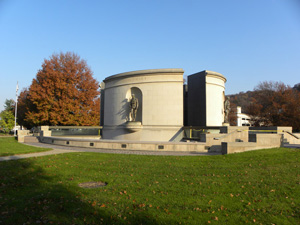

Remember...
James Franklin Bolyard
1924-1944
"When you go home
Tell them of us, and say
For your tomorrow,
We gave our today."
Patrick O'Donnell
 |
Remember...James Franklin Bolyard
|
James Franklin Bolyard was born on May 27, 1924, in Kingwood, Preston County, West Virginia to Howard and Gladys Wilson Bolyard. His siblings, Robert and Helen, were both younger than he. In 1930, Mr. Bolyard was an enumerator collecting the U.S. Federal Census data. In 1940, he was working as a salesman at a gasoline station. The family lived in Rowlesburg.
James Bolyard attended basic training at Camp Barkeley, Texas. He seems to have had hope for the future because he attended Texas A & M for three months while he was there, perhaps determined to complete his education despite the interruption of a war. He was transferred to Camp Howze, Texas. Camp Howze was a training camp at which the 84th, 86th, and 103rd Divisions were prepared for war. (Brian Harte, "Camp Howze," Texas State Historical Association: Handbook of Texas, accessed 30 September 2021, https://www.tshaonline.org/handbook/entries/camp-howze.) On March 1, 1944, James Bolyard was assigned to the 103rd Division, an infantry division, and eventually attached to the Seventh Army. ("Former Student Killed in Action," The Buckhannon Record, 23 February 1945.)
By January 1944, the command of the Seventh had passed from Lt. General George Patton to Lt. General Mark Clark. Under Patton, the Seventh was the first U.S. unit to see combat in World War II in Italy. By 1944, the Seventh was inactive in Sicily and Algiers as its leadership planned for the invasion of southern France. Research did not reveal exactly when James Bolyard joined his unit or where he was stationed, but it's likely he was with them by the time that the Seventh commenced Operation Dragoon under General Alexander Patch. The unit first staged in Naples in July 1944 and then landed on the beaches of southern France in August 1944. The Seventh liberated all of southern France before meeting up forces that had executed the invasion at Normandy. ("History: Seventh Army," 70th Infantry Division Association, accessed 30 September 2021, https://www.trailblazersww2.org/history_seventharmy.htm.)
The history of the Seventh Army prepared by the 70th Infantry Division Association notes:
The Army then assaulted the German forces in the Vosges Mountains, broke into the Alsatian Plain, and reached the Rhine River after capturing the city of Strasbourg. During the Battle of the Bulge, the Seventh Army extended its flanks to take over much of the Third Army area which allowed the Third to relieve surrounded U.S. forces at Bastogne. Along with the French First Army, the Seventh went on the offensive in February of 1945 and eliminated the enemy pocket in the Colmar area.
Pfc. James Bolyard died due to injuries sustained in action near Strasbourg on December 8, 1944. A hospital admission card found for Pfc. Bolyard on Fold3 indicates that he was admitted as a battlefield casualty injured by artillery shell fragments. His status is not clear at the time of admission, but he was discharged due to death. The death notice published in The Buckhannon Record states that he was killed in action.
Article prepared by Cynthia Mullens
September 2021

West Virginia Archives and History welcomes any additional information that can be provided about these veterans, including photographs, family names, letters and other relevant personal history.